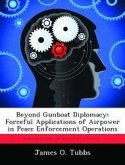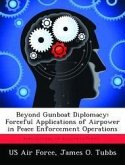The United States Air Force has become increasingly involved in peace enforcement missions throughout the world since the end of the Cold War. Recent examples include Operations Allied Force and Deliberate Force in the Balkans, and Operations Northern Watch and Southern Watch in Iraq. While monitoring no-fly zones is the most obvious mission assigned to air forces conducting peace enforcement operations, it is not the only way in which airpower contributes. Other missions include enforcement of sanctions and exclusion zones, protection of shipping, strikes and raids, and shows of force. In order to perform these missions, the basic U.S. Air Force combat functions must be adapted to fit the unique environment of the peace enforcement operation. Although peace enforcement missions may differ considerably from traditional combat, United States Air Force doctrine provides only broad guidance on how basic functions apply to peace enforcement. U.S. Air Force Doctrine Document 2-3, Military Operations Other Than War, states that Air Force units support peace enforcement with traditional air-to-air and air-to-ground operations, but does not describe how these operations are conducted or integrated with the joint force. Instead, the U.S. Air Force believes that normal operational doctrine provides sufficient guidance to accomplish these missions. This monograph challenges the claim that normal U.S. Air Force operational doctrine provides an acceptable basis for peace enforcement. Specifically, the monograph determines whether current U.S. Air Force doctrine promotes effective air interdiction in a peace enforcement operation, using a division-sized land component as a model. The author has determined three criteria for effective air interdiction in peace enforcement operations: unity of effort, responsiveness, and flexibility. These criteria provide a lens through which to examine the suitability of current doctrine to the challenge of providing effective air interdiction t
Hinweis: Dieser Artikel kann nur an eine deutsche Lieferadresse ausgeliefert werden.
Hinweis: Dieser Artikel kann nur an eine deutsche Lieferadresse ausgeliefert werden.








